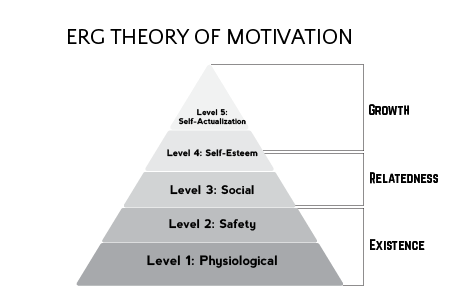ERG theory of motivation is the condensed form of Maslow’s Hierarchy of Needs. The theory was developed by Clayton Paul Alderfer, an American psychologist, and consultant, between the 60s and the 70s, based on the empirical study conducted at a factory in Easton, Pennsylvania.
Maslow’s Hierarchy of Needs has been criticized and modified by various critics, among which Alderfer’s is probably the most interesting and logical one. Alderfer has compacted Maslow’s five needs into three broad categories – Existence, Relatedness, and Growth, based on which the theory has been named as ERG Theory of motivation. ERG theory alike Maslow’s theory describes the needs in the pecking order.

Categories of ERG Theory of Motivation
| S.N. | Categories | Meaning |
|---|---|---|
| 1. | Existence (E) | It is concerned with basic human survival needs. |
| 2. | Relatedness (R) | It includes human desires to satisfy interpersonal and social relationships. |
| 3. | Growth (G) | It is concerned with the desire to make growth and personal development. |
Explanation of Categories
Existence needs (E)
What Maslow had described as “physiological needs” and “safety needs” were merged together by Alderfer to constitute existence needs. The group is concerned with basic physical needs and security needs, without which human body will fail to function properly, and ultimately break down.
An employee won’t be motivated to work unless his physiological needs such as food, shelter, clothing, sleep, etc. are being fulfilled. While materialistic requirements relatively satisfy the employee, his behavior is significantly affected by the safety needs. Here, safety is concerned with both physical as well as economic. Any employee would be motivated to continue working only when his health, financial and other personal security is ensured.
Relatedness needs (R)
The need for love, friendship and other intrapersonal relationship, which were categorized as “belongingness” in Maslow’s Hierarchy of Needs were included in this group.
It is the necessity of all humans to have a good relationship with the ones who are present around him. Thus, he always looks for a good working environment where he can establish a good relationship with his superiors, colleagues or subordinates. Such workplace which consists of hostile employers or co-workers contributes to grievances and conflicts, which in long run can increase labor turnover rate.
Growth needs (G)
The intrinsic desire for progress and development which were categorized as “esteem” and “self-actualization” by Maslow was fitted by Alderfer into this group.
An employee feels highly motivated when he realizes the outcomes or consequences of his efforts. The consequences might be feeling of achievement, respect from others, goal actualization, increase in knowledge, etc. In absence of these factors, an employee can never be happy with his job.
Conclusion
Priority of needs differs from person to person. However, Alderfer has been able to broadly classify and prioritize these needs.
According to him, existence needs are the most concrete, which is followed by relatedness needs and growth needs, consecutively.
He has added that existence needs are easiest to verify and can be easily generalized than that of relatedness needs and growth needs which are complex to generalize. He has also mentioned that individuals tend to amplify their efforts in lower categories when they are unable to reach the needs of a higher category.
How is ERG Theory of Motivation different than Maslow’s Hierarchy of Needs?
| S.N. | Maslow’s Hierarchy of Needs | ERG Theory of Motivation |
|---|---|---|
| 1. | This theory was proposed by Abraham Maslow. | This theory was proposed by Clayton Paul Alderfer. |
| 2. | Level of needs is approached step-by-step. | Different level of needs can be pursued simultaneously. |
| 3. | The hierarchical aspects are rigid. | The order of needs can be different for different people. |
| 4. | It has not explained anything about frustration-regression principle. | It has a frustration-regression element. This principle states that if upper-level needs are unsatisfied or unfulfilled, people become frustrated and return to pursue lower level again. |
Implication of ERG Theory of Motivation
- HR managers who hold to this theory recognize that employees have several needs to satisfy side-by-side. In addition, in absence of growth and developmental opportunities, employees revert to relatedness needs. If the managers are able to timely identify this situation, steps can be taken to focus on fulfillment of relatedness needs so that the employees become able to pursue their growth need again.
- Financial incentives are known to satisfy employee’s need and motivate them to continue their efforts to the accomplishment of personal and organizational objectives. However, this theory has clarified that these incentives have no effect on employees whose existence needs have not been fulfilled yet.
